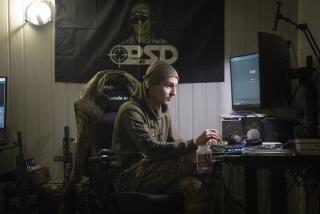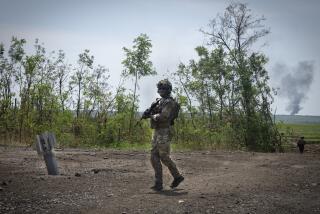Pentagon Gathering Bosnia Intelligence for Targets, Tactics : Military: Weather and terrain may be a problem, but it’s unclear how effective the Serb fighting force is.
- Share via
WASHINGTON — As the United States and its allies weigh possible military action against the Bosnian Serbs, the Pentagon has begun intensifying its efforts to marshal allied intelligence data to help plot possible targets and tactics, analysts here say.
Led by the Defense Intelligence Agency, the military is gathering a wide array of information, ranging from photographs taken by U.S. spy satellites to firsthand reports from allied troops on duty in Bosnia-Herzegovina and from recent refugees.
What has emerged is a picture of a combat zone in which weather and terrain would pose serious challenges to the allies. But it also appears that the potential enemy’s firepower is limited to relatively unsophisticated weapons and that its supply lines could be disrupted with little difficulty.
Still unclear is the likely effectiveness of the Bosnian Serbs’ fighting force--whether the 40,000-man army would prove troublesome for the United States or is undisciplined and apt to run quickly, as some experts contend.
George Kenney, an expert on Eastern Europe at the Carnegie Endowment for International Peace, says the paradox posed by Bosnian Serb troops may prove one of the thorniest--and most frustrating--challenges for any allied intervention forces.
“For the most part, the Serb forces aren’t a credible fighting force and wouldn’t fight very well,” Kenney contends. “These are criminal gangs much more than military units. It’s mainly the officers who are even trained. In any real crunch, most of them would flee.”
At the same time, Kenney cautions, the absence of any real discipline means that die-hard Serbian guerrillas would likely continue to be a threat far longer than conventional forces might be. “Once you’re there, you (would) have to stay there for a long time,” he says.
Defense analysts say a stepped-up pace of intelligence gathering on Bosnia began early in March, when the United Nations first raised the possibility that it might need troops to enforce a U.N.-brokered peace accord and that the North Atlantic Treaty Organization might get the job.
Over the past few months, both U.S. and NATO intelligence-gathering agencies have been sharpening their focus, steadily increasing the number of passes by spy satellites over Bosnia. British, French and Canadians on U.N. humanitarian missions have also been interviewing refugees.
But weather--and the mountainous terrain--has been hampering some efforts. Adding to the difficulties, the Bosnian Serbs’ arsenal is stashed in mountain caves--first used during the regime of Yugoslav dictator Josip Broz Tito--and is thus out of range of aerial photography equipment.
Jeffrey Richelson, an analyst with the National Security Archives, said that if a military confrontation came, the allies would be able to use satellites--and some ground stations in the region--to monitor the Serbian forces’ radio transmissions.
Unfortunately, however, there is a shortage of skilled linguists capable of translating such transmissions. For that reason, intelligence agencies have begun advertising for former Cold War interpreters, hoping some might want to return to work.
Defense analysts say the Serbian forces’ arsenal is respectable but mostly old and unsophisticated. They are thought to have no real ballistic missiles, such as the Iraqi Scuds that posed a threat to ground troops during the Persian Gulf War.
Their antiaircraft weapons also are limited--a few aging, radar-guided SA-2, SA-3 and SA-6 Soviet-made surface-to-air missiles and some SA-14 shoulder-fired surface-to-air missiles that can home in on heat emanating from aircraft.
Defense analysts say both are relatively easy to knock out or thwart through decoys or evasion tactics and that the Serbs have no network of sophisticated command centers and antiaircraft radar installations, such as the Iraqis had built up before the Gulf War.
The Serbs have one major long-range-radar tracking station at the southern tip of Bosnia, 20 miles south of Sarajevo. Experts say that undoubtedly would be one of the first targets of any allied air strike.
Military analysts say the Serbs’ most worrisome weapons are its 600 artillery pieces, hundreds of mortars and 500 T-54 and T-55 tanks--the latter hidden in mountain caves. They also have antiaircraft artillery that could discourage the allies from flying at low altitudes, at least initially.
The artillery would be relatively easy to eliminate if the United States sent in ground troops. Such troops could serve as spotters and could operate TPQ-36 counter-battery radar that can help knock out enemy artillery pieces or mortars within seconds after they have been fired.
If the U.S. action is confined to air strikes, however, analysts say it would be more difficult to destroy artillery pieces--particularly without spotters. Military experts have speculated that Washington might send in a few spotters and ground artillery units despite a no-ground-troops pledge.
Bosnia’s mountainous, tree-covered terrain and frequently cloudy skies also would add to the problems, although experts say that U.S. pilots are trained to cope with both factors and that the aircraft they would use are capable of conducting all-weather operations.
It is not yet clear yet whether allied air attacks would be extended into Serbia to knock out supply lines from Belgrade. Analysts said that decision probably would depend upon how well Serbian President Slobodan Milosevic keeps his word on cutting off supplies to the Bosnian Serbs.
More to Read
Sign up for Essential California
The most important California stories and recommendations in your inbox every morning.
You may occasionally receive promotional content from the Los Angeles Times.










